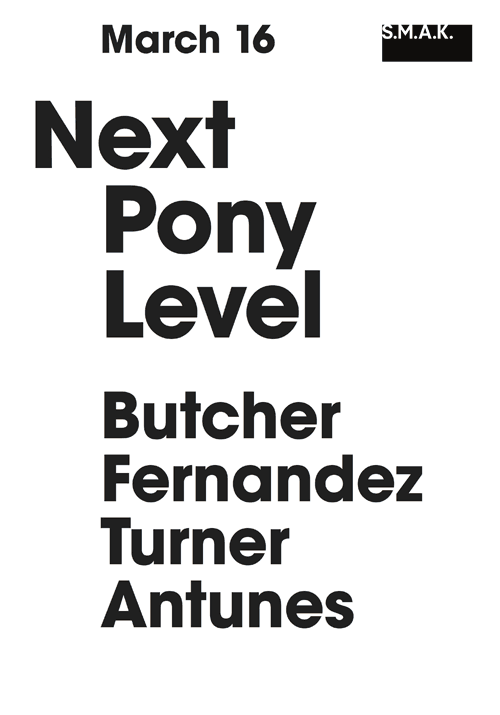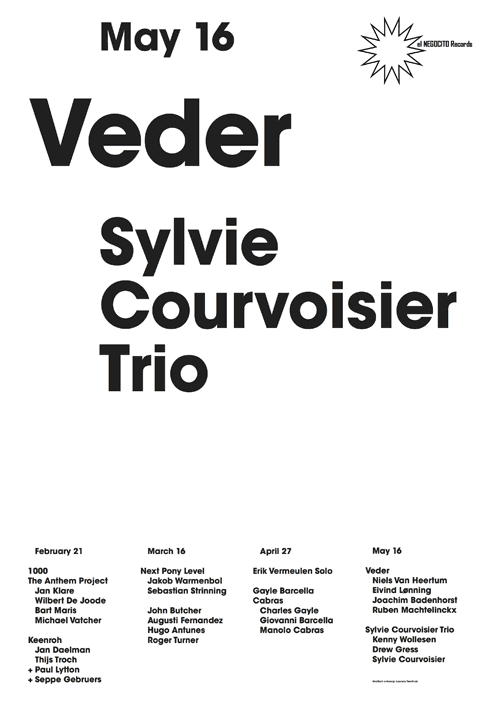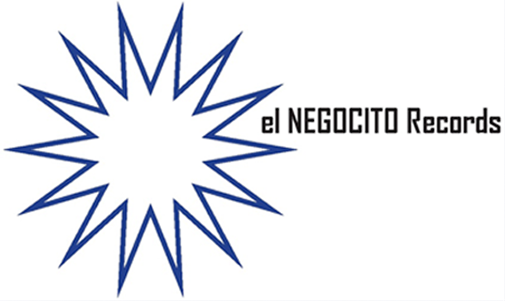LINE UP CITADELIC@SMAK 17
location: S.M.A.K. museum
Jan Hoetplein 1, Ghent
other concerts
thursday 27 APRIL
20H
ERIK VERMEULEN solo
21H15
GAYLE BARCELLA CABRAS
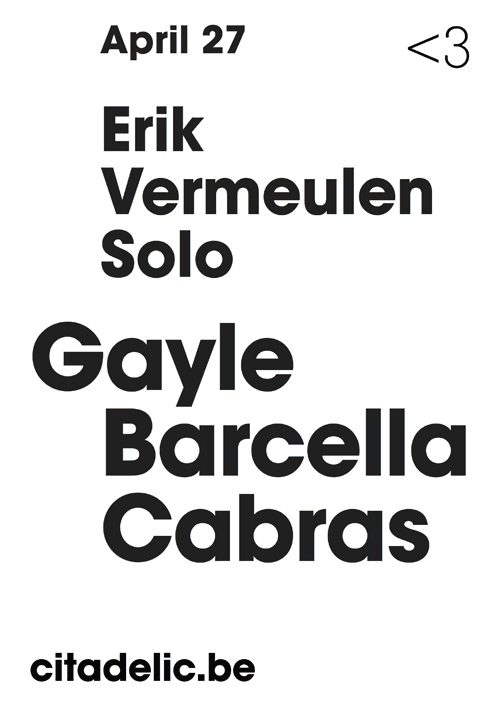
archive 2015
archive 2016
for reservation (VVK) mail info@citadelic.be
tuesday 21 february 2017
20H - 1000 anthems to work on a good end
The quartet "1000" started in 2004, recomposing classical compostions. 2015/16 the idea of a new repertoire, based on national anthems came up. Hymns in general help to identify with other people, playing a national anthem is immediately also a political act. The fact that a melody is a point of reference for a whole naEon, makes an interpretation of that melody recognizable for everybody. If you take Mauricio Kagel ́s composition "10 marches, to fail victory", you can see how populistic elements can be used for very subtle manipulation. Karl Heinz Stockhausen states naEonal anthems as "the most popular, you can think of".Afghanistan has had 6 different anthems in the 20th century that reflect polical changes, very similar to Cambodia. They form the core of our project. Next to Afghanistan and Cambodia we present anthems, that have been chosen strictly on artistic reasons, plus two melodies, that have been specifically composed for this project. You will hear the national anthem of Syria in combination with a song from early 19th century, that was used as an unofficial anthem during the 2nd french empire, glorifying the colonization of the world and Syria.
The fact that many anthems sound alike has mostly historical reasons, but there are many hymns with very different character. We have selected 2 early chinese hymns and the anthem from Niue (an atoll in the south-pacific) purely for their beauty. Our european anthems are quoted in an arrangement of the eurovision-melody by Charpentier. There are also 2 original compositions - one of them the "anthem of Utopia", the other one - "Refugia" is surely not a fesEve song, but an adempt, to musically sketch the escape of a human being from his home.
The selection of these songs as well as their interpretaEons are not researched by musicologists - the choice was made intuitively and is based on the impulse to play melodies. Our interest is how melodies effect humans and how anthems work for a gathering of people. We are not trying to make an up-to-the-minute political statement. Some of our arrangements may irritate people, but will hopefully not insult anybody.
Jan Klare : reeds
Bart Maris: trompet
Wilbert de Joode: bass
Michael Vatcher: percussion
PROGRAM:
1. Europa (Marc Antoine Charpentier)
2. Partant pour la syrie (Hortense de Beauharnais)
3. Syrien (Mohammad und Ahmad Salim Flayfel)
4. Afghanistan
Many peoples have crossed the territory that nowadays is called Afghanistan, heading to wards the warm and ferEle India. In the middle of the 18th century a state was founded, that later became Afghanistan. In the beginning of the 19th century Russia subjected the northern neighbors of Afghanistan. From the southeast british India approached. Finally only Afghanistan was leg over between Russia and the British. Britain was afraid the Russian could conquer Afghanistan and adacked the country in 1839 and 1878. In 1919 the afghan people adacked the british territory and won their sovereignty. 1978 pro-russian military staged a coup and tried to establish a communist government. This brought the Mujaheddin to the scene. The USSR send troops in 1979 to help the afghan communists. But they could not win against the Mujaheddin, which were supported by the West. At the end of 1991 the USSR vanished and in 1992 also the afghan communists gave in. The Mujaheddin were the new leaders in Kabul. 1994 the Taliban movement took over. But ager 9/11 the USA started to overthrow the Talibansystem.
4a. 1926 - 43 (unknown) - The first anthem used by Afghanistan was during its period as a monarchy, and was performed on state visits by the King. I don't believe there are any words to this anthem.
4b. 1943 - 73 (Mohammed Farukh) - Wriden in 1930, this was the second anthem in use while Afghanistan was sEll ruled by an imperial family.
4c. 1973 – 78 (Abdul Ghafoor Breshna) - Ager the abolition of the monarchy in 1973, the Republic of Afghanistan was set up, and this anthem was adopted.
4d. 1978 – 92 (Jalil Zaland) - The lyricist of the anthem, which was in use during the communist rule in Afghanistan, was a leading legist poet in the country, who was also involved in communist and legist political parties of the era. 4e. 1992 - 99, 2002- 06 (Ustad Qasim) - Following the establishment of the Islamic Republic, a new anthem for Afghanistan, a Mujaheddin badle song, composed back in 1919, was granted along with other new national symbols. During the rule of the Taliban over Afghanistan, from 1999-2002, Afghanistan was in the unique position of not having
a naEonal anthem, as the Taliban, a strict Islamic religious party, banned music throughout the country. Upon the restoral of the government, the old former anthem was reinstated, but a new anthem was soon requested to once again reflect the new Afghanistan.
4f. 1999- 2002 During the rule of the Taliban over Afghanistan, from 1999-2002, Afghanistan was in the unique position of not having a naEonal anthem, as the Taliban, a strict Islamic religious party, banned music throughout the country.
4g. 2006 (Babrak Wasa) Afghanistan's constitution states that the National Anthem of Afghanistan must be in the Pashto language and that it must contain the phrase "Allahu Akbar" (God is Great). It must also menEon the names of the ethnic groups in Afghanistan.
5. Refugia (Jan Klare)
PAUSE
1. Utopia (Jan Klare)
2. China 1911-12 (Bo Tong)
3. China 1915-16 (Wang Lu)
4. Cambodia
The earliest hints on sedlement in the tropical region date from about 4200 BC. There is proof, that a wealthy kingdom existed in the 5th century AD on the territory of today ́s Cambodia, called Funan. At the end of the 7th century Funan was conquered by the kingdom of Chenla. Both empires were inhabited by Khmer, the people of modern Cambodia. The "Angkor"-empire, established around 802 – 850, was highly civilized. with approximately 1 million Khmer living there. In 1430/31 it was conquered by the Thai people. Thailand and Vietnam fought heavily for the leading role in Cambodia and introduced a common administration 1841. In order to remain in power, the cambodian king signed a treaty with France in 1863 – from 1941 the Japanese reigned Cambodia, but in 1946 the French came back. They allowed the cambodians their own constitution and political parties. In the 1950s Cambodia's fight for independence started. From 1953 king Sihanouk took over the country. Ager a coup Lon Nol abolished monarchy and founded the Khmer-republic. The exiled Sihanouk organized the takeover of the Khmer Rouge under Pol Pot 1975 – the worst Eme in Cambodia's history with 20 and 30% of the populaEon being killed. 1976 the "Democratic Republic" was established. 1979 vietnamese troups seized Phnom Penh, 1989 they withdrew.
4a. 1941 - 70 (F. Perruchot/ J. Jekyll) - The anthem, the so called Nokoreach, was originally adopted in 1941 and reconfirmed in 1947, around the Eme of independence from France.
4b. 1970 – 75 (wriden collecEvely) - In the 1960s, Cambodia became more and more involved into the Vietnam War. In 1970, General Lon Nol lead a military coup against Sihanouk and formed a pro-American government, the "Khmer Republic". The country got a new flag and national anthem, which remained in use until the communist Khmer Rouge seized power in 1975.
4c. 1975 - 76 (F. Perruchot/ J. Jekyll) - When the Khmer Rouge conquered Phnom Penh 1975, they first restored the old royalist symbols of state and made Prince Sihanouk again head of state.
4d. 1976 - 79 (unknown) - But in 1976, the Khmer Rouge declared Cambodia the "Democratic Kampuchea", and adopted its own anthem.
It has been suggested that Pol Pot may have wriden this anthem himself. Since the Khmer Rouge were recognized as the legitimate government of Cambodia by the United NaEons, its anthem conEnued to be presented as the national anthem of Cambodia in the West until the restoration of the monarchy in 19
4e. 1979 - 89 (unknown) - Ager Vietnamese forces invaded Cambodia 1979, Cambodia became the "People's Republic of Kampuchea". Again, a new flag and naEonal anthem was adopted.
In 1989, the government, in an adempt to gain greater international recogniEon, changed the state symbols. Not much is known about the anthem used from 1989-1991. In 1991, a UN peace plan was signed. Some sources menEon a textless tune, composed by Prince Ranariddh, was used as the naEonal anthem during this Eme, yet not much is known about this anthem.
4f. 1993 (F. Perruchot/ J. Jekyll) In 1993, the monarchy was restored and internaEonally recognized as the government of Cambodia.
5. Niue (unknown)
21H15 - KEENROH + LYTTON + GEBRUERS
A project where Keenroh and Seppe Gebruers invite British percussionist Paul Lytton for an electro-acoustic adventure. The unique interaction between acoustic improvisation and the electronic processing will create new and exciting music.Paul Lytton has been on the forefront of improvised music since the late sixties together with Evan Parker, Derek Bailey, Barry Guy, Paul Lovens, … His unique and constantly evolving musical language makes him one of the greatest musicians of this time. His distinct playing will surely enrich and inspire the music of the duo Keenroh.
Seppe Gebruers' role is surprising and extraordinary. He will be recording the acoustic sound of every musician (flute, piano and percussion) and will instantly process these sounds through a string of electronic devices. The output of this is transmitted through different speakers who are set up throughout the space to communicate with the other improvisers...
Keenroh the flute / piano duo consists of Jan Daelman and Thijs Troch. In 2014 they successfully launched their debut album at el NEGOCITO Records. Following the prize "Young Jazz Talent Ghent '2014 they released in November 2015, also at the same Ghent-based label, their second album' Keenroh XL ', this time with a comprehensive nine-member band (Teun Verbruggen Bart Maris, Laurens Smet, Niels of Heertum Thomas Jillings, Marti Melia, Ruben Verbruggen).
The duo draws their inspiration from the rich aural transfer of past decades and improvises with a common language which they have developed through a long musical journey together.
Keenroh also already worked with several guest musicians including Peter Jacquemyn Marek Patrman Giovanni Barcella, Joao Lobo, Manolo Cabras, Norberto Lobo, Michel Massot, Laurent Blondiau ... Both musicians are also active in several other projects such Jukwaa, Kabas, Glin Faction, Residuum Free Unit Hypochristmutreefuzz, PeedVed, DST trio, Northern Escorts, ...
Thijs Troch: piano
Jan Daelman: flutes
Seppe Gebruers: live electronic processing
Paul Lytton: drums & percussion
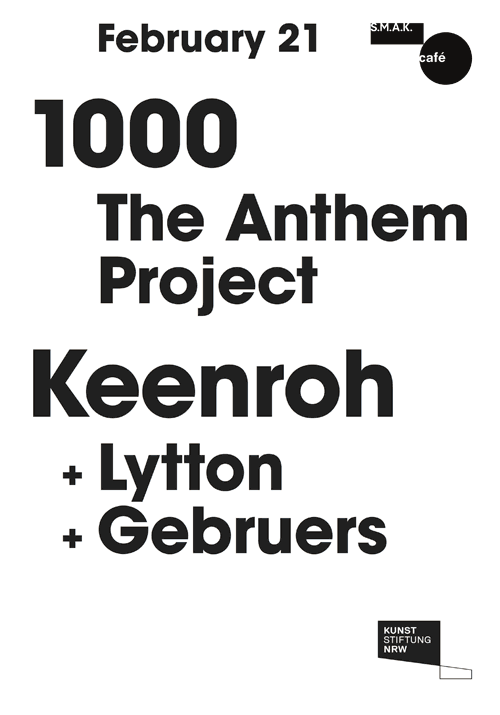
supported by:

Follow @citadelic
NEWS
30 january 2015
We will program concerts in co production with SMAK at the Museum. 3 spring dates to follow soon !!!
8 august 2014
Citadelic Festival edition 8 from 28 til 31st of may
8 june 2014
Atelier sessions announced... release eNR022 / new kid on the bloc on piano Kaja Draksler / Giovanni Barcella as Robin Hood
17 may 2014
helterskelter... programm on the way; poster by smeraldina-rima etc.
